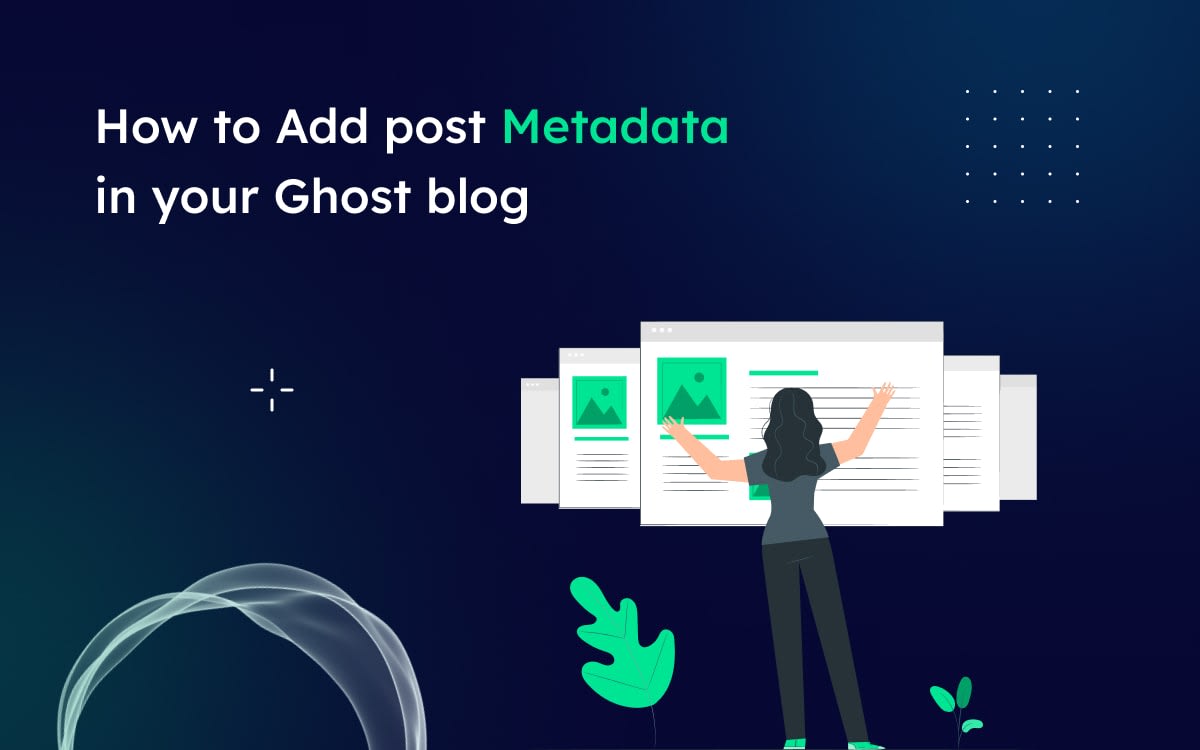In the realm of blogging, post metadata plays a crucial role in enhancing the visibility, searchability, and accessibility of your content. It serves as a set of informative labels that provide search engines and social media platforms with valuable insights into the context and substance of your blog posts.
By incorporating post metadata into your Ghost blog, you can effectively optimize your blog for search engines, enhance social media sharing, and improve the overall user experience for your readers. You can also add reading time to Ghost blog posts to give readers a quick estimate of how long it will take to read your content.
In this blog, we will explore the importance of post metadata and guide you on how to add metadata to your Ghost blog, empowering you to optimize your content and make a lasting impact in the digital realm.
You will learn from this blog:
- Introduction
- What is Post metadata?
- Benefits of adding post-metadata
- How to Add Post Metadata to Your Post
- Summary
- FAQs
What is Post metadata?
Post metadata is additional information about a post that provides context and enhances its visibility in search engines and social media platforms. It's like a set of labels or tags that describe and categorize the post, making it easier for search engines to understand its content and for readers to find relevant information.
Ghost provides a set of built-in post settings where you can add essential metadata fields:
- Meta Title: This is the title that will be displayed in search engine results and social media shares. It should be concise, descriptive, and accurately reflect the post's content.
- Meta Description: This is a summary of your post that will be displayed in search engine results and social media shares. It should be enticing, informative, and relevant to the post's topic.
- Canonical URL: This is the URL of the canonical version of your post, ensuring that search engines prioritize the correct version and avoid duplicate content issues.
- OG Image: This is the image that will be displayed when your post is shared on social media platforms like Facebook, Twitter, and LinkedIn. Choose an engaging and high-quality image that represents the post's content.
Adding post metadata to your blog posts is essential for SEO and social media optimization. It helps search engines understand the content of your posts, making them more likely to appear in relevant search results. It also provides valuable information to social media users, making it more likely that they will share your posts.
How to Add Post Metadata to Your Post
To add metadata using the built-in post settings, follow these steps:
Step 1: Open the post editor
Go to the Ghost admin panel and navigate to the "Posts" section. If you want to Edit an existing post then click on the ghost post title or if you want to create a new post then click the "New Post" button.
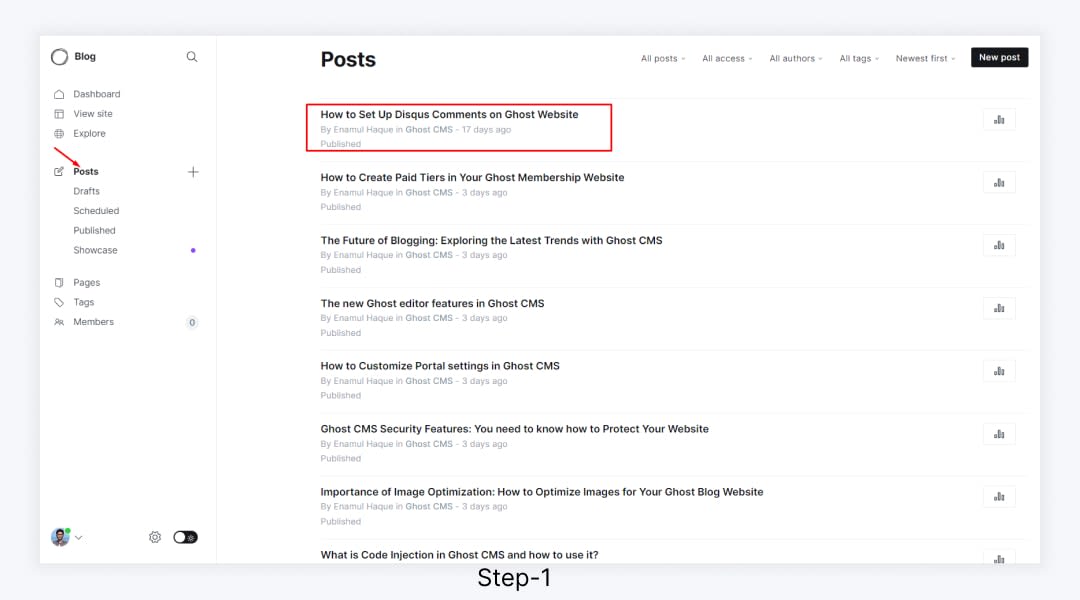
Step 2: Access the post settings
In the right corner of the editor, expand the "Settings" section.
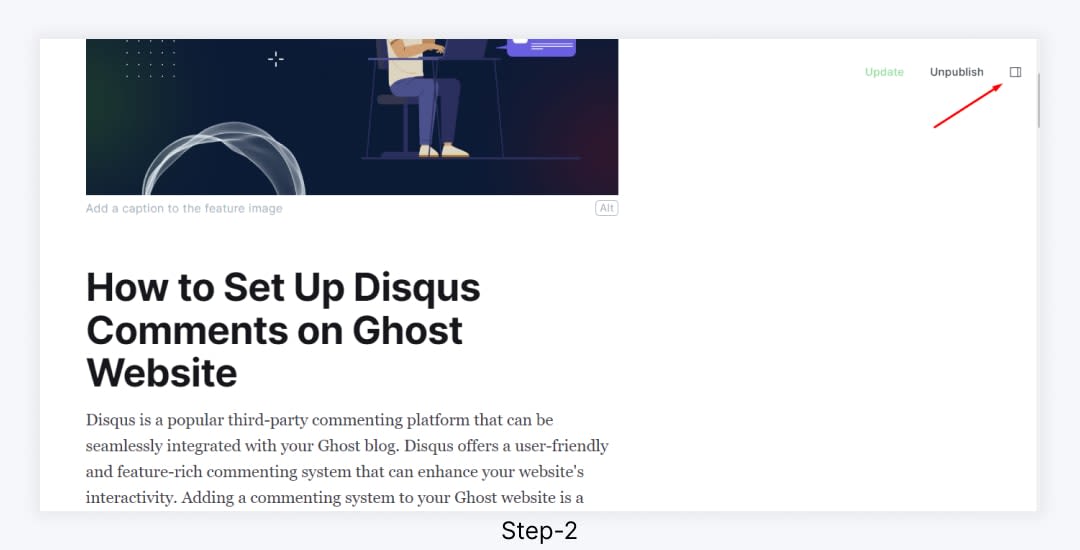
Step 3: Add metadata
Go to the Meta Data option and fill in the fields for the metadata you want to add, such as meta title, meta description, and canonical URL.
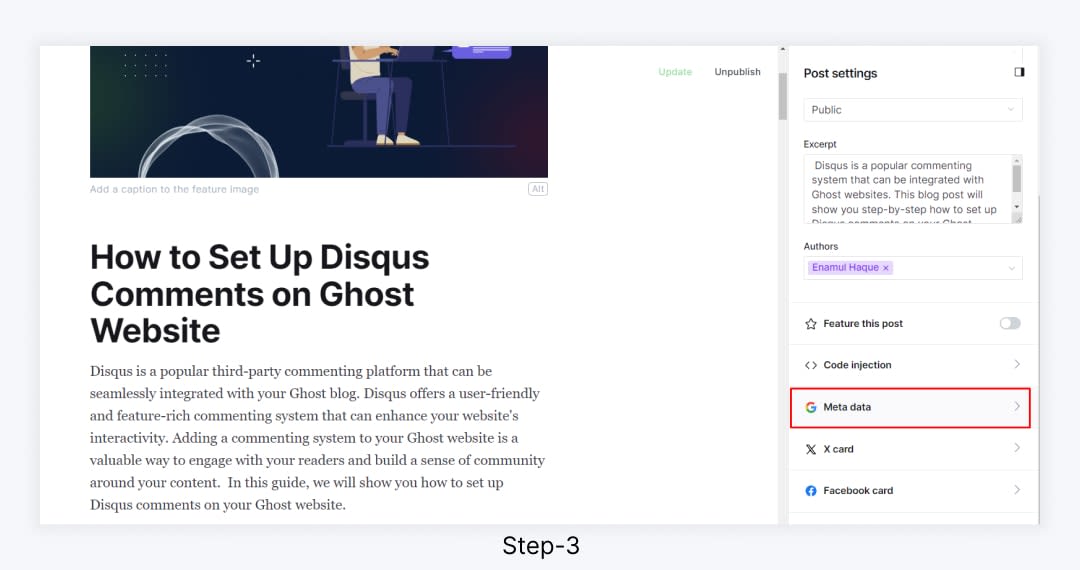
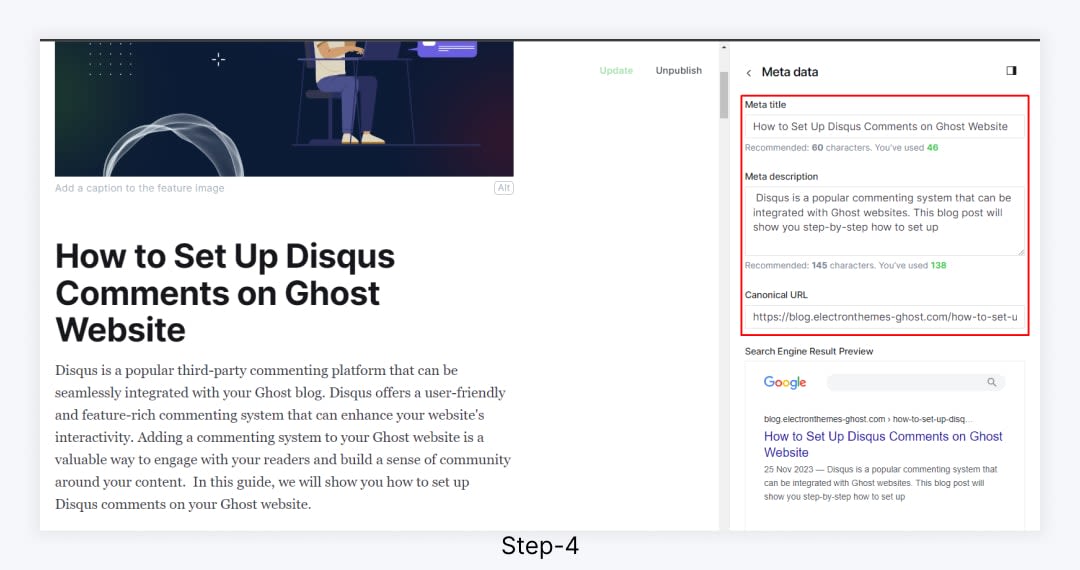
Ghost Post Editor: Step 3 and 4
Step 4: Save your changes
If you customize an existing blog then Click on the "Update" button or if you create a new post then click on the "Publish" button to save your changes.
Ghost Metadata
Benefits of adding post-metadata
Here are some of the benefits of adding post metadata to your blog posts:
- Improved Search Engine Optimization (SEO): Search engines use metadata to understand the content and relevance of posts, influencing their ranking in search results. Well-structured metadata helps search engines accurately categorize and index posts, increasing their visibility to users seeking relevant information.
- Enhanced Social Media Sharing: Post metadata makes your posts more shareable on social media by providing social media platforms with the information they need to display them correctly. When sharing posts on social media platforms, metadata like the title, description, and featured image are displayed as a preview. Compelling metadata encourages social sharing and expands the post's reach.
- Improved User Experience: Post metadata provides users with additional context and information about your posts, making it easier for them to find relevant content. This enhances the overall user experience, allowing readers to quickly identify and access the information they seek.
- Structured Data Integration: Post metadata can be utilized to integrate structured data into your blog posts. Structured data provides search engines with more detailed information about your content, further improving SEO and enabling richer search results.
- Content Organization and Categorization: Post metadata can be used to organize and categorize your blog posts effectively. This helps readers easily navigate through your blog and find content that aligns with their interests.
Overall, adding post metadata to your blog posts is a simple but effective way to improve your blog's SEO, social media presence, and user experience.
Summary
Incorporating post metadata into your Ghost blog posts is an essential step towards enhancing the overall effectiveness of your content. By providing valuable information to search engines and social media platforms, you can significantly improve your blog's visibility, engagement, and user experience. Remember, post metadata is not just about boosting SEO; it's about making your content more accessible, discoverable, and valuable to your readers.
FAQs
Do you have any questions about How to add post metadata to your Ghost blog? We have answers to some frequently asked questions on the topic.
Why is post metadata important?
Post metadata is important because it helps search engines understand the content of your posts, making them more likely to appear in relevant search results. It also provides valuable information to social media users, making it more likely that they will share your posts.
What are some tips for adding post metadata to my Ghost blog?
Here are some tips for adding post metadata to your Ghost blog:
- Use concise and descriptive meta titles and descriptions.
- Assign relevant tags to your posts.
- Use custom fields to store additional information about your posts.
- Review your post metadata regularly to ensure it is accurate and up-to-date.
How can post metadata impact SEO?
Search engines rely on metadata to index and rank content. Properly optimized metadata, including keywords in tags, meta descriptions, and categories, can significantly improve a blog's search engine visibility. This, in turn, attracts more organic traffic and increases the likelihood of reaching a broader audience.
What are some common mistakes to avoid when adding post metadata?
Here are some common mistakes to avoid when adding post metadata:
- Don't stuff your meta titles and descriptions with keywords.
- Don't use misleading or inaccurate meta titles and descriptions.
- Don't use duplicate meta titles and descriptions.
- Don't use irrelevant tags.
You may also like it!
- Change Ghost Theme and Adjust Settings in Ghost CMS– Learn how to change your Ghost theme and adjust the settings to give your website a fresh, personalized look and functionality.
- How to add a social sharing button on a post in Ghost CMS– Explore how to easily integrate social sharing buttons on your Ghost CMS posts to boost content engagement and reach.
- How to Set Up Disqus Comments on Ghost Website– Enhance your website's interaction by setting up Disqus comments in Ghost, creating a secure and engaging comment section for visitors.
- How to Customize Portal settings in Ghost CMS– Discover how to customize the portal settings in Ghost to match your website’s branding and improve user experience.
- Future of Blogging: Latest Trends with Ghost CMS– Stay ahead of the curve by exploring the latest trends in blogging with Ghost CMS and how it can transform your content strategy.
